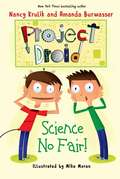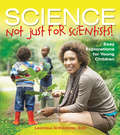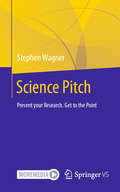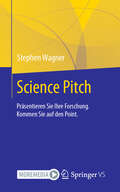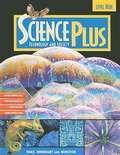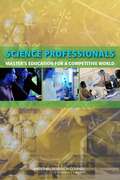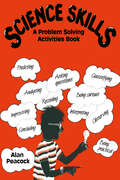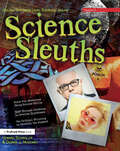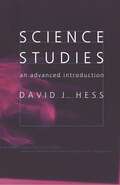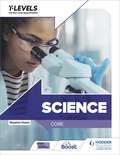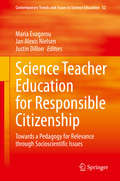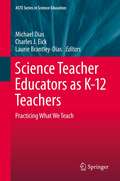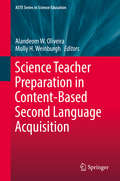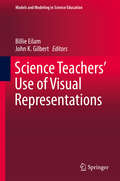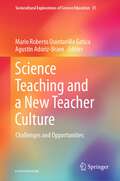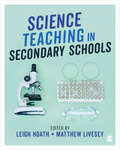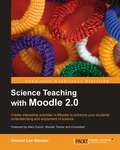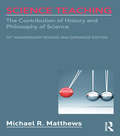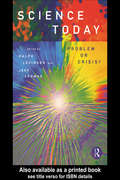- Table View
- List View
Science No Fair!: Project Droid #1 (Project Droid)
by Nancy Krulik Amanda Burwasser Mike MoranHilarious story about a slightly crazy science and engineering experimentLogan Applebaum tries to keep his new robot cousin, Java, a secretLogan’s science fair rivals steal Java, and Logan worries they’ll discover Java’s true identity If you thought your science fair experience was nerve-wracking, try being Logan Applebaum. One day, his inventor mother declares that she made a new robot cousin for Logan, Java. Java might be incredibly bright, but he’ll also be quite the handful. Logan had a picture of how the third grade would go. Java was not part of that picture. As the third grade science fair gets closer and the kids prepare for their experiments, Logan thinks Java will come in handy. He can at least help Logan beat the Silverspoon twins, who always win everything. Unfortunately for Logan, the twins Sherry and Jerry steal Java as their partner. Even worse, these kids become suspicious. Can Logan work quickly enough to keep a crazy experiment from becoming a crazier disaster? Join mother-daughter author duo Nancy Krulik and Amanda Burwasser as they introduce the comedic pair of Logan and Java. This first installment of their Project Droid #1 story reminds readers of Amelia Bedelia with a delightful modern edge. Science No Fair! is an excellent pre- bedtime book choice.
Science Not Just for Scientists: Easy Explorations or Young Children
by Kathy Lee Carole H. DibbleWith quick and simple ideas, 101 Easy, Wacky, Crazy Activities is guaranteed to enliven any day. Try Tongue Painting (yes, Tongue Painting!) or Squishy Squeezy (a clean and messy activity!) and open the door to creative discovery. Encourage children to think creatively, problem solve, and have fun while learning. Written by two experienced teachers, this collection of open-ended ideas is a book teachers and parents will want to keep handy. -
Science Pitch: Present your Research. Get to the Point
by Stephen WagnerHow can scientists present their projects with power to the point? This book is the ultimate guide for transforming complex research into captivating, convincing Science Pitches in a given time. The innovative ESPRIT model equips scientists with tools to blend professional expertise with personal passion, ensuring every presentation resonates deeply with its target audience. This concise manual combines research excellence and professionalism. It integrates artificial intelligence (AI) applications and slide design. Practice-oriented advice is enriched with real-world examples preparing for outstanding presentations. Designed for students and researchers eager to gain visibility, this book is a unique guide to getting your message across; it advances your research and engages your audience. Unlock your project’s potential and wrap expertise and passion in unique science storytelling. The Science Pitch results in a convincing short talk, successful networking, and securing funding approval for the research project. Via app: Download the SN More Media app for free, scan a link with play button and access videos directly on your smartphone or tablet.
Science Pitch: Präsentieren Sie Ihre Forschung. Kommen Sie auf den Point.
by Stephen WagnerWie können WissenschaftlerInnen ihre Projekte mit Power auf den Point präsentieren? Als ultimativer Leitfaden übersetzt dieses Buch komplexe Forschung in überzeugende Kurzvorträge. Das innovative ESPRIT-Modell gibt WissenschaftlerInnen die nötigen Tools an die Hand, um Professionalität mit Persönlichkeit zu verbinden und so ihr Zielpublikum zu überzeugen. Dieses Praxis-Handbuch integriert Anwendungen der Künstlichen Intelligenz (KI) und Foliengestaltung. Praxisorientierte Tipps mit konkreten Beispielen zeigen auf, wie Studierende und Forschende sichtbar als ExpertInnen wahrgenommen werden können. Mit diesem einzigartigen Leitfaden können sie prägnante Botschaften vermitteln sowie fachliche Expertise und persönliche Leidenschaft zu einem einzigartigen wissenschaftlichen Storytelling verbinden. Der Science Pitch ermöglicht überzeugende Kurzvorträge, erfolgreiches Networking und die Zusage von Fördermitteln für Forschungsprojekte.
Science Plus Technology and Society: Level Blue
by Charles Mcfadden Robert E. YagerThis new United States edition has been adapted from prior work by the Atlantic Science Curriculum Project, an international project linking teaching, curriculum development, and research in science education. There are many things to try, create, and to investigate--both in and out of class. There are stories to read, articles to think about, puzzles to solve, and even games to play.
Science Plus: Technology and Society (Level Blue)
by Holt Rinehart WinstonDevelop your Science skills using Science Plus--like observing, experimenting, and explaining observations and ideas.
Science Professionals: Master's Education For A Competitive World
by National Research Council of the National AcademiesWhat are employer needs for staff trained in the natural sciences at the master's degree level? How do master's level professionals in the natural sciences contribute in the workplace? How do master's programs meet or support educational and career goals? Science Professionals: Master's Education for a Competitive World examines the answers to these and other questions regarding the role of master's education in the natural sciences. The book also focuses on student characteristics and what can be learned from efforts underway to enhance the master's in the natural sciences, particularly as a professional degree. This book is a critical tool for Congress, the federal agencies charged with carrying out the America COMPETES Act, and educational and science policy makers at the state level. Additionally, anyone with a stake in the development of professional science education (four year institutions of higher education, students, faculty, and employers) will find this book useful.
Science Reporter May 2019
by Csir PublicationThis magazine Science Reporter May 2019 is usefull for the competitive exams for the monthly current affairs.
Science Skills: A Problem Solving Activities Book
by Alan PeacockThis is a practical book for pupils, designed to teach the basic skills of scientific investigation and problem solving. With an emphasis on skills not facts, it is practical in approach, describing over 100 activities. No specialised apparatus is required and the investigations it covers are flexible enought to relate to any science course.
Science Sleuths: Solving Mysteries Using Scientific Inquiry (Grades 6-9)
by Howard Schindler Dennis J. MucenskiBuilding on the growing public interest in forensics, the three cases featured in Science Sleuths: Solving Mysteries Using Scientific Inquiry merge science and literacy, requiring students to be critical and active readers as they conduct their investigation. Beginning with an evaluation of the crime scene photos, the student investigators will analyze lab reports, phone messages, and interviews to extract key information. Students will sort through the evidence to formulate their initial hypothesis (being alert to red herrings) as they work to identify the person responsible for each crime. Students are given additional sets of information as they make their way through the case, requiring them to reformulate their initial hypothesis until they arrive at a final conclusion. The students' final write-up consists of a chart explaining the means, motive, and opportunity for each of the suspects, in addition to a thorough analysis of the evidence and a recreation of the case. Eventually, students are able to determine which suspect should be charged with the crime!Students will:solve fun mysteries using science skills,sort through evidence to develope hypotheses, anduse critical thinking to identify the suspect.Grades 6-9
Science Studies: An Advanced Introduction (Writing Science Ser.)
by David J. HessThe first comprehensive survey of the nascent field of "science studies"Thrust into the public eye by the contentious "Science Wars"—played out most recently by physicist Alan Sokal's hoax—the nascent field of science studies takes on the political, historical, and cultural dimensions of technology and the sciences. Science Studies is the first comprehensive survey of the field, combining a concise overview of key concepts with an original and integrated framework. In the process of bringing disparate fields together under one tent, David J. Hess realizes the full promise of science studies, long uncomfortably squeezed into traditional disciplines. He provides a clear discussion of the issues and misunderstandings that have arisen in these interdisciplinary conversations. His survey is up-to-date and includes recent developments in philosophy, sociology, anthropology, history, cultural studies, and feminist studies. By moving from the discipline-bound blinders of a sociology, history, philosophy, or anthropology of science to a transdisciplinary field, science studies, Hess argues, will be able to provide crucial conceptual tools for public discussions about the role of science and technology in a democratic society.
Science T Level: Core
by Stephen HoareStart your journey towards a career in science. Covering all the Core content you need to know with clear definitions alongside practice questions, this T level textbook gives you the skills and confidence to succeed in your written assessment and industry placement. Created in partnership with NCFE and written by highly respected author Stephen Hoare. - Get started with short, clear summaries and learning outcomes at the beginning of each chapter- Develop the scientific, mathematical, technical and communication skills you need- Track your progress and check understanding using the 'Test yourself' activities - Understand and remember key scientific terms using the highlighted definitions- Prepare for your placement with tips on best practice in the workplace, alongside case studies and activities that reflect real-life situations and build problem-solving skills- Approach assessment with confidence using the knowledge-based questions and scenario-based activities for practice, alongside model answers for the extended response questionsThis textbook covers the Core content for Science T Level. The Occupational Specialisms for this course are: Laboratory Sciences, Food Sciences and Metrology Sciences.
Science Teacher Education for Responsible Citizenship: Towards a Pedagogy for Relevance through Socioscientific Issues (Contemporary Trends and Issues in Science Education #52)
by Justin Dillon Maria Evagorou Jan Alexis NielsenThis edited book aims to provide a global perspective on socioscientific issues (SSI), responsible citizenship and the relevance of science, with an emphasis on science teacher education. The volume, with more than twenty-five contributors from Africa, North and South America, Asia, Australasia and Europe, focuses on examples from in- and pre-service teacher training. The contributors expand on issues related to teachers’ beliefs about teaching SSI, teachers’ challenges when designing and implementing SSI-related activities, the role of professional development, both in pre- and in-service teacher training, in promoting SSI, the role of the nature of science when teaching SSI, promoting scientific practices through SSI in pre-service teaching, and the role of indigenous knowledge in SSI teaching. Finally, the book discusses new perspectives for addressing SSI in teacher education through the lens of relevance and responsible citizenship.
Science Teacher Educators as K-12 Teachers: Practicing what we teach
by Laurie Brantley-Dias Michael Dias Charles J. EickScience teacher educators prepare and provide professional development for teachers at all grade levels. They seek to improve conditions in classroom teaching and learning, professional development, and teacher recruitment and retention. Science Teacher Educators as K-12 Teachers: Practicing What We Teach tells the story of sixteen teacher educators who stepped away from their traditional role and entered the classroom to teach children and adolescents in public schools and informal settings. It details the practical and theoretical insights that these members of the Association of Science Teacher Educators (ASTE) earned from experiences ranging from periodic guest teaching to full-time engagement in the teaching role. Science Teacher Educators as K-12 Teachers shows science teacher educators as professionals engaged in reflective analysis of their beliefs about and experiences with teaching children or adolescents science. With their ideas about instruction and learning challenged, these educators became more aware of the circumstances today's teachers face. Their honest accounts reveal that through teaching children and adolescents, teacher educators can also renew themselves and expand their identities as well as their understanding of themselves in the profession and in relation to others. Science Teacher Educators as K-12 Teachers will appeal to all those with an interest in science education, from teacher educators to science teachers, as well as teacher educators in other disciplines. Its narratives and insights may even inspire more teacher educators to envision new opportunities to serve teachers, K-12 learners and the local community through a variety of teaching arrangements in public schools and informal education settings.
Science Teacher Preparation in Content-Based Second Language Acquisition
by Alandeom W. Oliveira Molly H. WeinburghThe primary purpose of this book is to provide science teacher educators with exemplars of professional development programs designed to prepare school teachers to effectively help language learners in science classrooms simultaneously gain language proficiency and conceptual understanding. To this end, this book examines seventeen science teacher preparation programs that span a wide variety of grade levels (elementary, middle, and secondary), countries (Italy, Luxemburg, Spain, UK, and US), and linguistic contexts (English as a Second Language, English as a Foreign Language, trilingual classrooms, and teaching deaf children science through sign language). The book is divided into three main parts. Each part consists of chapters that illustrate a common, cross-cutting theme in science teacher preparation in content-based second language acquisition, namely pre-service teacher preparation, in-service teacher preparation, and international perspectives. Each part provides many insights on the similarities and differences in the professional development approaches used to prepare science teaching with varied amounts of instructional experience help students in different parts of the world overcome linguistic barriers while simultaneously learning concepts central to science. Bringing together researchers from various academic backgrounds (science education, TESOL, and Applied Linguistics), attention is given to varied facets of the intersection of science and language learning in the specific context of school teacher preparation.
Science Teachers' Use of Visual Representations
by Billie Eilam John K. GilbertThis book examines the diverse use of visual representations by teachers in the science classroom. It contains unique pedagogies related to the use of visualization, presents original curriculum materials as well as explores future possibilities. The book begins by looking at the significance of visual representations in the teaching of science. It then goes on to detail two recent innovations in the field: simulations and slowmation, a process of explicit visualization. It also evaluates the way teachers have used different diagrams to illustrate concepts in biology and chemistry. Next, the book explores the use of visual representations in culturally diverse classrooms, including the implication of culture for teachers' use of representations, the crucial importance of language in the design and use of visualizations and visualizations in popular books about chemistry. It also shows the place of visualizations in the growing use of informal, self-directed science education. Overall, the book concludes that if the potential of visualizations in science education is to be realized in the future, the subject must be included in both pre-service and in-service teacher education. It explores ways to develop science teachers' representational competence and details the impact that this will have on their teaching. The worldwide trend towards providing science education for all, coupled with the increased availability of color printing, access to personal computers and projection facilities, has lead to a more extensive and diverse use of visual representations in the classroom. This book offers unique insights into the relationship between visual representations and science education, making it an ideal resource for educators as well as researchers in science education, visualization and pedagogy.
Science Teaching Reconsidered: A Handbook
by Committee on Undergraduate Science EducationEffective science teaching requires creativity, imagination, and innovation. In light of concerns about American science literacy, scientists and educators have struggled to teach this discipline more effectively. Science Teaching Reconsidered provides undergraduate science educators with a path to understanding students, accommodating their individual differences, and helping them grasp the methods--and the wonder--of science.What impact does teaching style have? How do I plan a course curriculum? How do I make lectures, classes, and laboratories more effective? How can I tell what students are thinking? Why don't they understand? This handbook provides productive approaches to these and other questions.Written by scientists who are also educators, the handbook offers suggestions for having a greater impact in the classroom and provides resources for further research.
Science Teaching and a New Teacher Culture: Challenges and Opportunities (Sociocultural Explorations of Science Education #31)
by Mario Roberto Quintanilla Gatica Agustín Adúriz-BravoThis edited volume discusses various epistemological positions about science teaching and the complex processes of understanding and learning in the classroom. Including discussions around Natural Sciences teacher training models, as well as the development of logics of reflection on practice based on critical and dialogic interpretative visions guiding higher level competency learning. It brings together contributions from researchers promoting a coherent and robust methodological analysis, theoretically based on the systematization of evidence in different contexts within Europe and Latin America.While supporting innovation in teacher training and science teaching, it offers specific contributions and suggestions for classroom work in the subjects of Physics, Chemistry and Biology. It includes didactic guidelines for experimental practices, for the evaluation of scientific learning, as well as for the use of epistemology and the history of science in teaching. In addition, it’s considered an important contribution to the challenge of rebuilding science education programs as well as its correct implementation in schools and universities. This book is a translation of an original Spanish publication. The translation was done with the help of artificial intelligence (machine translation by the service DeepL.com). A subsequent human revision was done primarily in terms of content, so that the book will read stylistically differently from a conventional translation.
Science Teaching in Secondary Schools
by Leigh Hoath Matthew LiveseyThis book is your essential guide to secondary science teacher training and the early career years giving smart, practical advice on developing your classroom skills and deepening your knowledge of science education. Covering all major aspects of science teaching, including: planning and assessment, the power of subject knowledge, teaching tricky topics and health and safety in class and lab work, it will encourage you to develop an informed approach to allow you to shine as an early career teacher of science. Key features: · Real life examples of how important teaching principles work in practice · What to look for when observing others teaching · Reflective questions challenging you to engage with key ideas · Chapters linked to the Core Content Framework and Early Career Framework Leigh Hoath is a Senior Professional Practice Fellow at Leeds Trinity University. Matthew Livesey is a teacher of biology at Bradford Grammar School.
Science Teaching in Secondary Schools
by Leigh Hoath Matthew LiveseyThis book is your essential guide to secondary science teacher training and the early career years giving smart, practical advice on developing your classroom skills and deepening your knowledge of science education. Covering all major aspects of science teaching, including: planning and assessment, the power of subject knowledge, teaching tricky topics and health and safety in class and lab work, it will encourage you to develop an informed approach to allow you to shine as an early career teacher of science. Key features: · Real life examples of how important teaching principles work in practice · What to look for when observing others teaching · Reflective questions challenging you to engage with key ideas · Chapters linked to the Core Content Framework and Early Career Framework Leigh Hoath is a Senior Professional Practice Fellow at Leeds Trinity University. Matthew Livesey is a teacher of biology at Bradford Grammar School.
Science Teaching with Moodle 2.0
by Vincent Lee StockerPacked with lots of practical examples, each chapter takes you through a different aspect of teaching using Moodle. All examples are based around a sample science course, which you can see growing throughout the book.This book is for science teachers who would like to enhance their lessons using Moodle. It doesn't matter if you haven't used Moodle before; as long as someone has set it up for you, you can get started with the exercises in the book straightaway.
Science Teaching: The Contribution of History and Philosophy of Science, 20th Anniversary Revised and Expanded Edition
by Michael R. MatthewsScience Teaching explains how history and philosophy of science contributes to the resolution of persistent theoretical, curricular, and pedagogical issues in science education. It shows why it is essential for science teachers to know and appreciate the history and philosophy of the subject they teach and how this knowledge can enrich science instruction and enthuse students in the subject. Through its historical perspective, the book reveals to students, teachers, and researchers the foundations of scientific knowledge and its connection to philosophy, metaphysics, mathematics, and broader social influences including the European Enlightenment, and develops detailed arguments about constructivism, worldviews and science, multicultural science education, inquiry teaching, values, and teacher education. Fully updated and expanded, the 20th Anniversary Edition of this classic text, featuring four new chapters—The Enlightenment Tradition; Joseph Priestley and Photosynthesis; Science, Worldviews and Education; and Nature of Science Research—and 1,300 references, provides a solid foundation for teaching and learning in the field.
Science Term 3 class 9 - Tamil Nadu Board
by Government TamilnaduThis book is developed in a holistic approach which inculcates comprehending and analytical skills. It will be helpful for the students to understand higher secondary science in a better way and to prepare for competitive exams in future. This textbook is designed in a learner centric way to trigger the thought process of students through activities and to make them excel in learning science.
Science Today: Problem or Crisis?
by Ralph Levinson Jeff ThomasWhat is science? What is the purpose of science education? Should we be training scientists, or looking towards a greater public understanding of science? In this exciting text, some of the key figures in the fields of science and science education address this debate. Their contributions form an original dialogue on science education and the gener
Science Videos: A User's Manual For Scientific Communication
by Ryan VachonEffective science communication is no easy task. While the effective conveyance of technical knowledge presents formidable roadblocks to sharing scientific knowledge and discoveries, certain communication tools like video and film production help to bridge this gap. This user’s manual provides a complete set of easy-to-follow directions for video-making as well as tricks of the trade to leverage these skills to better inform the intended audience.
